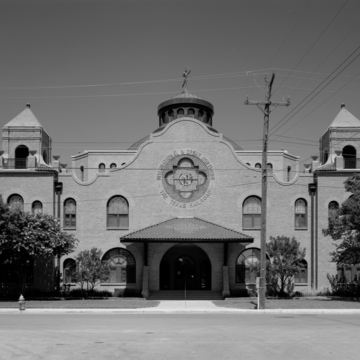The International and Great Northern Railway arrived in San Antonio in 1881. Replacing an earlier depot, the present structure was built four years after the Southern Pacific depot ( SA60), resulting in a station that clearly surpasses its competitor in scale and impact. Initially serving only Texas, the International and Great Northern was later acquired by Jay Gould, providing a rail link to St. Louis, Missouri. After closing in 1970 and surviving a fire in 1982, the depot was adapted for use as the San Antonio City Employees Federal Credit Union in 1988. The exterior of the square structure is dominated by four Alamo parapets, one on each side, which partially obscure the dome, which is topped by a bronze sculpture of a Native American archer that was the railroad's symbol. The interior, with the dome supported on a ring of massive Tuscan columns, is one of the great spaces in San Antonio. The railroad's emblematic stained glass windows survived the fire.
Directly across Medina Street are remnants of the development that grew up around the station, two former hotels, the largest of which, with a three-story veranda across its facade, was built by the railroad to serve travelers departing from the station.















